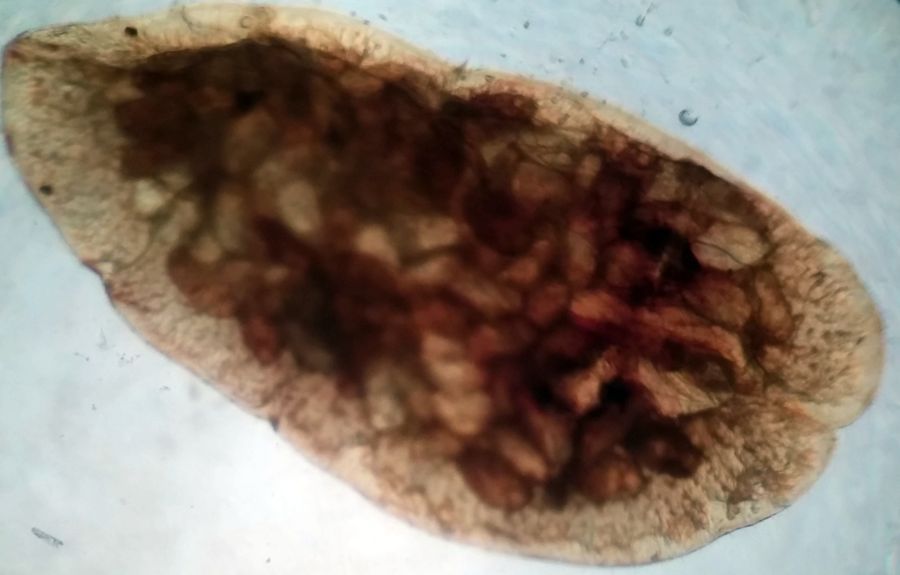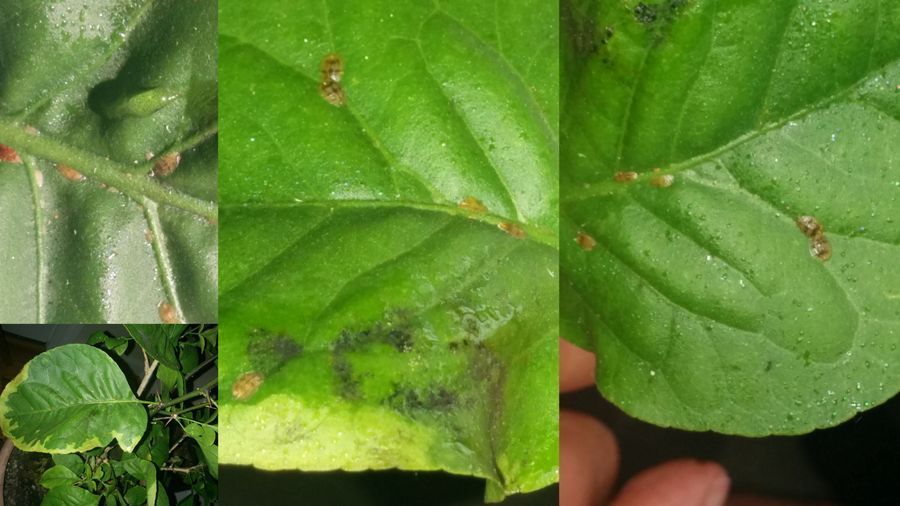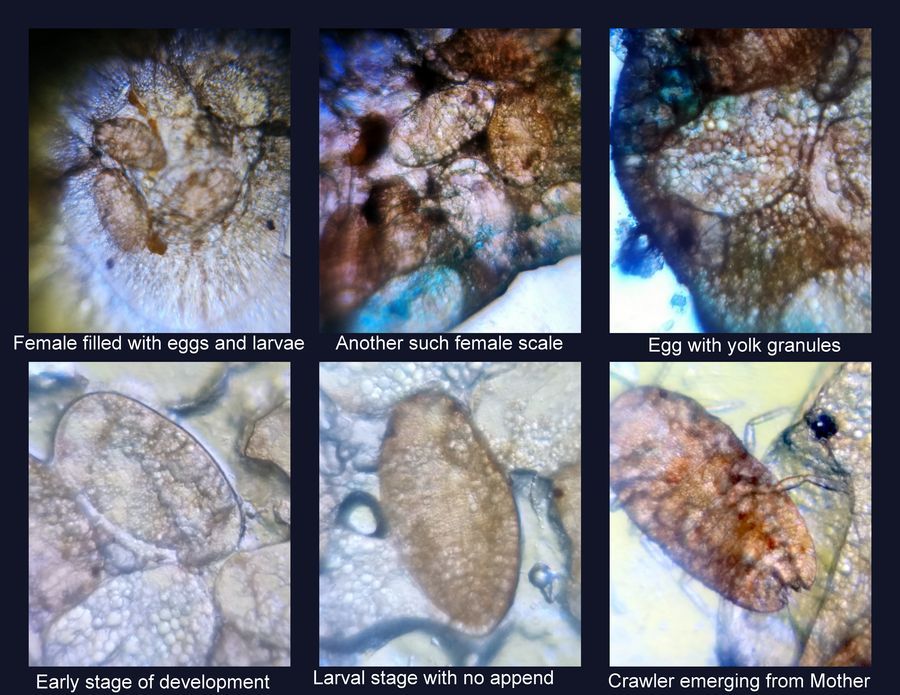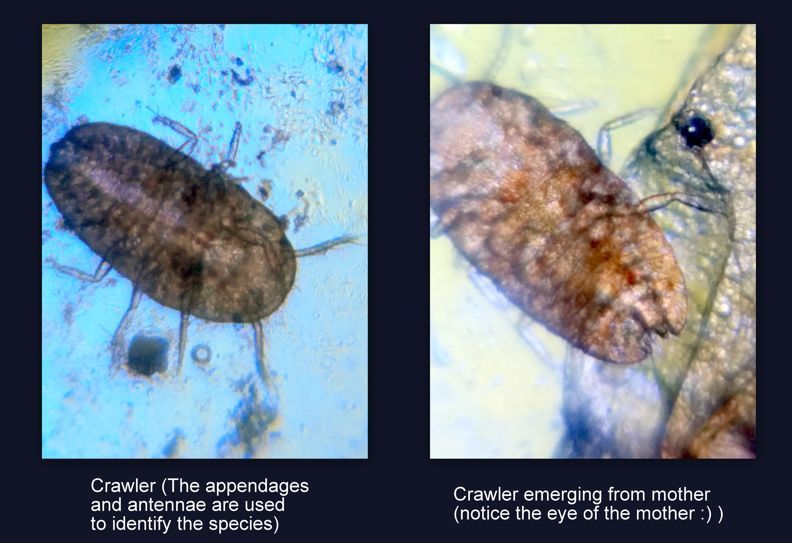Two animals, a fungus and a houseplant — Part I. The scale insect
 Jan 26, 2015 • 6:29 PM UTC
Jan 26, 2015 • 6:29 PM UTC Unknown Location
Unknown Location 140x Magnification
140x Magnification Microorganisms
Microorganisms
laksiyer
Human observer of life. https://sukshmadarshin.wordpress.com
97posts
1255comments
5locations

Anyone who tends houseplants indoors knows the risk of inviting other uninvited guests — in particular various arthropods and fungi. However, with a foldscope this transforms into new material for investigations. I have been growing a wood-apple tree (called Bilva in India; Aegle marmelos) for a few years now. This is a very popular and hardy tree in the Indian subcontinent and grows very slowly. In winters, my plant resides indoors in comfortable heated environments and year after year, it gives me heartaches with the pests it attracts when inside. However, a pest is only a human perspective, the evolution of flowering plants and insects is very intimate and goes back 250 million years, way before our primate ancestor existed– so from their perspective I am perhaps the pest.
In any case, a few days ago, I noticed that several of its leaves were shiny and sticky and there were little waxy bumps on the leaf surface. There was also a black growth. I knew I had double-trouble. The waxy protrusions are scale insects, members of the order hemiptera that suck the sap drawn from the plant’s vascular system and secrete a sticky and presumably sweet honeydew. This promotes the growth of a black fungus that can inundate the plant preventing it from gaining access to light and making it look rather unaesthetic. This also may attracts ants. Additionally, while I watered the plant a few fungal gnats startled from the stream buzzed around the soil and they seemed to be thriving in my negligence. However, now along with my plant were two animals and a fungus– all great material for a foldscope party. In the first part, I shall describe some images of the scale insect.
In any case, a few days ago, I noticed that several of its leaves were shiny and sticky and there were little waxy bumps on the leaf surface. There was also a black growth. I knew I had double-trouble. The waxy protrusions are scale insects, members of the order hemiptera that suck the sap drawn from the plant’s vascular system and secrete a sticky and presumably sweet honeydew. This promotes the growth of a black fungus that can inundate the plant preventing it from gaining access to light and making it look rather unaesthetic. This also may attracts ants. Additionally, while I watered the plant a few fungal gnats startled from the stream buzzed around the soil and they seemed to be thriving in my negligence. However, now along with my plant were two animals and a fungus– all great material for a foldscope party. In the first part, I shall describe some images of the scale insect.

Scale insects are hemipterans of the Stenorrhyncha t ype closely related to aphids and white flies. All the scales I saw on my plant are likely to be female. For this, I took a cellophane tape and placed it over the leaf and pulled out the scales (they came off easily) and stuck it on a glass slide. Under a 40x microscope here is what a scale looks like. You can see the eyes of the female (two dots) in the anterior end (top left). Legs and antennae are not seen because by the time this female scale becomes an adult it either loses these appendages or they are very reduced in size compared to the rest of the body. The female sticks its proboscis into the leaf vasculature, secretes honeydew and makes descendants. The female scale insect encloses eggs and nymphs at various developmental stages in a brood chamber.

Within the mother scale insects, I could spot several stages of development of the growing nymph (see foldscope images below). The eggs with yolk granules, the nymphs with eyes and no appendages, that with appendages, and the crawler ready to leave from the mother scale. This form of development is called ovovivipary where the eggs remain within the mother until they hatch. The eggs however are nourished by the egg yolk and not the mother as in viviparous animals.

Upon completion of the first instar (under the mother’s care), the nymph is called a crawler and has appendages and antennae and leaves the mother scale to found its own colony. I realized to my horror that if one scale had these many scale-lings, I am done for! Here is a nice picture of the crawler showing all aspects of scale insect anatomy (Foldscope 140x).

Since I have a new-found love for my own movies, here is one showing a scale with nymphs and eggs at various stages of development (Foldscope 140x).
Here is another one combining two videos. In the first, you see these beating tubes in the scale (are they the multiple hearts? of the insect or perhaps a digestive action of sucking and excretion, both of which the scale does in plenty), and in the second two crawlers (now past their first instar) are trying to emerge from the mother scale insect.
Thus far I know that this is a soft-scale insect and would be classified as hemipteran -> Sternorrhyncha > Coccidae. There is this wonderful website for identifying scale insects http://idtools.org/id/scales/key.php?key=soft. I realized that there are several key characters one should pay attention to, such as number of antennal segments and the presence of marginal setae in the adult female scale for identification. However, with great impulse and curiosity, I shot an email to a leading expert on scale insects and he, to my delight, replied immediately that it was a brown soft scale ( Coccus hesperidum ). Also this far, as far as I can see, there were no males as they appear to be only occasionally produced and the adults are winged, but perhaps it is not the season for them, or perhaps I am not looking for them properly. Now all this means that I need to read up on Coccus hesperidum and recapitulate observations already made and reported in the literature (Sometimes I wish I was 10 again) and look for new things. Happy to learn about scale insects. Now onwards to the fungus. To be continued ….
Sign in to commentNobody has commented yet... Share your thoughts with the author and start the discussion!

 0 Applause
0 Applause 0 Comments
0 Comments_300x300.jpeg)

















